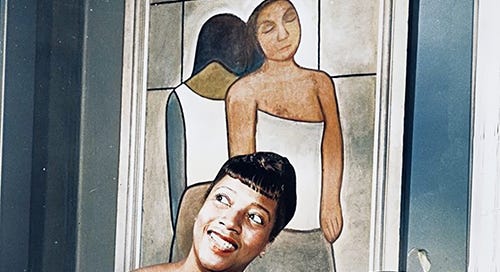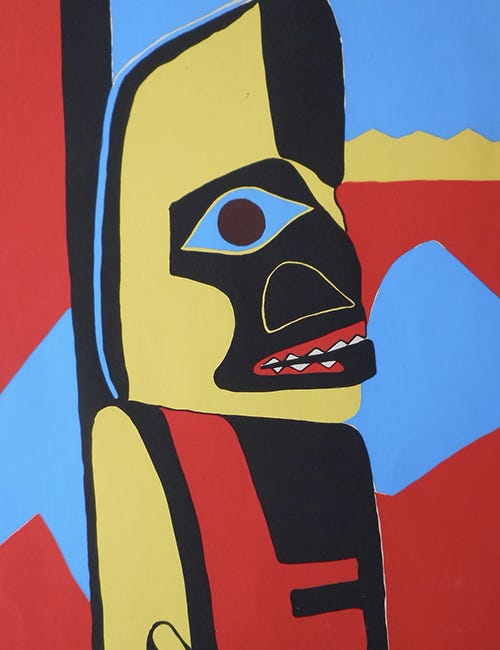
Thelma Johnson Streat was born on August 29, 1912, in Yakima in Washington State, the daughter of artist James Johnson and his wife, Gertrude. Streat was of African American and Cherokee heritage and grew up feeling lonely and isolated in predominantly white neighbourhoods. The family moved frequently during her early years, living in Pendleton, Oregon and Boise, Idaho before settling in Portland. Streat demonstrated her artistic talent early, beginning to paint when she was seven years old. By the time she graduated from high school in 1932, she was already exhibiting her work. One of her paintings received an Honorable Mention in a New York exhibition sponsored by the Harmon Foundation thanks to the support of Beatrice Morrow Cannady, a co-founder of the Oregon Chapter of the NAACP.

Streat studied art at the Museum Art School in Portland from 1934 to 1935 and took additional art courses at the University of Oregon from 1935 to 1936. She married Romaine Streat, a former boxer she met while he was posing for her life drawing class. Streat frequently exhibited her early work at local venues and participated in a second Harmon Foundation exhibition at the New York Public Library. Her first major success as a professional artist came when she sold four paintings to the renowned singer Roland Hayes.
In 1938, the couple moved to San Francisco where Streat worked with the Works Progress Administration (WPA) alongside sculptor Sargent Johnson and Ruben Kadish. She created five textile pieces for the New Deal public works program. Streat continued to gain recognition from galleries in Portland and the San Francisco Museum of Art, as well as African American exhibitions including one in Chicago in 1940. That same year, she participated in the exhibit Art in Action at the Golden Gate International Exposition where she assisted Diego Rivera with the Pan-American Unity mural. Streat was one of the few individuals Rivera trusted to complete the painting. Working with Rivera further sparked her interest in multiculturalism, a theme that would resonate throughout her career. Rivera also purchased a self-portrait by Streat for his personal collection.
Rivera praised Streat's work in a letter to Galka Scheyer, a German art dealer living in Los Angeles. He wrote: "The work of Thelma Johnson Streat is in my opinion one of the most interesting manifestations in this country at the present. It is extremely evolved and sophisticated enough to reconquer the grace and purity of African and American art."
Streat and her husband travelled extensively throughout Europe and Latin America, spending months abroad. She researched indigenous folklore and taught at various art schools. During her time in Ireland, Streat produced a significant amount of artwork. A gallery in New York sold 40 paintings of Irish Scenes within days of opening. Ireland’s prime minister Eamon De Valera hosted her. In the 1940s, Streat achieved national recognition with exhibitions of her work at several prominent galleries, including Stendahl Galleries in Los Angeles (1940), the M.H. de Young Museum in San Francisco (1941), the Raymond & Raymond Gallery in New York (1942), and the influential Little Gallery in Los Angeles, owned by Vincent Price (1943). Notable figures such as pioneering choreographer and activist Katherine Dunham, actor Fanny Brice, author Langston Hughes, industrialist Walter Paepcke and Eleanor Roosevelt purchased her work.

In 1942, Streat became the first African American woman to have a painting purchased by the Museum of Modern Art in New York. Her work, titled Rabbit Man, was featured in MoMA's exhibition New Acquisitions: American Painting and Sculpture that same year. This artwork revealed a blend of influences from African, Mexican, and Canadian Indigenous artists, which became indicative of her style. Streat displayed her designs for children's room decorations at the Western Living - Designs for Fine Modern Houses show at the San Francisco Museum that spring. In 1943, her painting Robot was featured in the International Exhibition of Water Colour at the Art Institute of Chicago.
During World War II, Streat’s painting Death of a Black Sailor illustrated the ongoing struggles faced by African American soldiers returning home from overseas. When the artwork was exhibited in Los Angeles, the gallery faced threats from the Ku Klux Klan. The artist remained steadfast and refused to give in to fear and the gallery kept the piece on display. Around 1944, Streat relocated to Chicago where she adopted a new approach and began creating a series of murals highlighting African Americans' positive cultural contributions. She entered her painting Women in Work in a competition at Chicago’s Southside Community Art Center, where it tied for first prize with William Carter. Streat also took on a role as chair of a committee that sponsored murals to support African American education.
By 1945, patrons had sponsored three murals: the first in New York City, the second in Chicago, and the third by a group from Portland. An article published in The Chicago Defender that same year reported that Streat had returned to the West Coast for the summer, with plans to return to Chicago that autumn. She spent time in Haida Gwaii studying the art, dance, and culture of the Haida people. The influence of these experiences was evident in her subsequent paintings and dance performances. Streat brought her still images to life by embodying their gestures on stage, infusing them with a dynamic energy. She performed at New York's Interplayers Theater at Carnegie Hall and the Museum of Modern Art. Streat toured Montreal, Paris, and London, where she performed for the King and Queen of Great Britain at Buckingham Palace. She received rave reviews as one of the early advocates of performance art.

In 1947, Streat was commissioned by the women’s sportswear manufacturer Koret to create original fabric designs for their spring collection. She also painted a series of canvases depicting the company’s spring 1948 fashions. After her divorce from Romaine, Streat married her manager Edgar Kline later that same year. The couple travelled throughout the U.S., Canada, Mexico, and Europe, and she performed for live audiences and on televised programs. Following their world tour, Streat and Kline settled in Hawaii in 1952. They dedicated themselves to education by establishing schools for young Hawaiians, promoting messages of tolerance and acceptance while exploring the common threads of all cultures.
In 1956, Streat and her husband founded a school on Salt Spring Island in British Columbia. She died suddenly of a heart attack three years later while studying anthropology at UCLA. Streat was 47 years old. In 2003, the Portland Art Museum held a posthumous solo exhibition of her work. Streat's paintings are a part of the collections at the Museum of Modern Art, Mills College in Oakland, California, the San Francisco Museum of Art, and the Honolulu Academy of the Arts. In 2016, her mural, Medicine and Transportation, was included in the permanent collection of the Smithsonian National Museum of African American History and Culture. Streat’s artistic legacy has been preserved thanks to her family. They have been dedicated to reviving interest in her career and her mission to unite people from diverse backgrounds through art and culture.

Keep reading with a 7-day free trial
Subscribe to Angela Rose Design to keep reading this post and get 7 days of free access to the full post archives.








